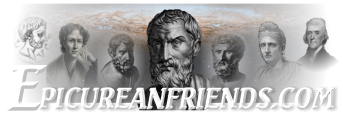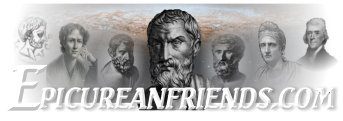p 39 Epicurean Sophos resembles somewhat primitive man. DRN 5.1241, 1161, 1143-44 mentions an ancient "Golden Age"
p 40 philosopher king was doomed when wealth became a value DRN 5.1136
ORGANIZATION
42 organization is a type of mediation between theory and practice, p. 36: all "healthy people" use hedonic calculus unconsciously, ergo the method is to make conscious the hitherto unconscious practices of healthy men, ergo, another BENEFIT OF EPICUREAN EDUCATION AND ORGANIZATION is **** unity of theory and practice ***
The school has three products: 1. a philosophical ideology, 2. an activity (education), 3. "mutually advantageous friendship"
p 45 Epicurean school is first secular institution of higher education in history *
Membership consisted of: 1. beginners (gnórimoi) and 2. advanced (symfilosophontes)
Book claims that E didn’t incorporate (as a non profit or, today, a 501c3) – is this true? I always thought his Garden was a thiasos
p 52 Epicurus gave a community to unrooted / rootless, marginalized intellectuals, 56-7 unorthodox sexuality p. 63 quote: **** Kepos was like a well-organized state **
E believed in private property
p 65 E mostly recruited long-term students of philosophy
RECRUITMENT
Two Recruitment tactics existed in antiquity: active pursuit (most common with other schools) or passive flight (Epicurean tactic, PD 14 cited). p. 48 Pyrrho served as a model in this. He "stayed away, talked to himself and was alone at leisure".
p 50 there was a private collection of books that members only read (so perhaps this was seen as one benefit of membership: access to advanced literature?)
p 69 recruitment takes place in a space that is liminal and initiatory p 70 the sense of identity of a recruit must be "threatened by an imminent danger or showing implementation is incorrect and must be rectified by conversion, so a recruit’s social allegiance or sense of personal identity can be attacked" - according to the author's "conversion theory". In Epicurus, the recruit ** himself ** goes to a place of liminality and the Epicureans concerned themselves with the psychology of conversion. p 76 recruit must be self-critical (sick, poor) and then self-renewing; consider "inadequacies of old self" vs the new self (healthy, whole), ergo conversion focuses on the medicinal aspect of philosophy
THE PSYCHOLOGY OF CONVERSION:
p 77 Epicurean gods also retired but still have an effect on humans. 82 the idea is to create "motivation" to adopt a new cognitive system, ergo pleasant impressions are used, the idea is to *** internalize them and to become a source of pleasure to oneself (p. 83) ***, to become like the Epicurean gods. A sage must naturally attract new followers. 85 mental interference can cause false thoughts or motivations, ergo without a correct mental constitution or disposition (diathesis), an individual is not receptive. (Diogenes also says we can control this disposition and it’s our most important source of happiness – PD 20)
TYPES
In XVII, E statue is described as a Hercules-like culture hero in his throne, a culture bringer, a Mahatma (or great soul), a sage, a healer or shaman-psychotherapist-medicine man (his image has been compared to Asklepius of Melos, which indicates a self-conscious presentation as a healer
Father-figure: both Lucretius and Philodemus (mentions "parricide") refer to Metrodorus and Hermarchus as fathers, not just E.
Hero: facial similarity to Hercules Farnese, p. 223-4 compared to Hercules who slays physical monsters, E. slays the monsters of the soul. Fusion of stoa and Cynicism took place in the 1st Century AD. Hercules embodied ponos (effort, sacrifice, shares semantic roots with pena/pain), autarchy, independence, free action, free love, scorn of civilization (p 228); ergo author argues Hercules comparison goes back to a 3rd Century anti-Cynic polemic
E as Savior: statue shows sympathy and awareness of the viewer. Model: Asclepius, fourth Century. Father-God’s warmth and sympathy for man grows in collective imagination after Alexander the Great / as civic gods grew cold / Asclepius cult grows, statue looks into the eyes of the worshiper, Asclepius heals the body whereas E heals the soul
Savior theme posits that society is always corrupt. Epicureans don’t try to change society, we create philosophical communities which must coexist with the dominant culture. Our legitimacy is not an imperative, but an existential fact (that is, we do not NEED to justify our inherent right to exist)
p 41 philosophy and politics are irreconciliable; ergo we choose personal salvation and group solidarity instead of utopian politics (Epicureans were a social club with economic ties) ***
Megalophychos or great mind, Mahatma: great in all virtues and self sufficient, indifference to fortune, love of friends. Lion-like, deep-set eyes
E as God: Throne was seat of Hegemon and of divine power. Throne was holy object itself; author says E was the "magnanimous new Father-God of wisdom, culture, and salvation"
THEORY OF CONVERSION
Epicurean "theory of motivation" – painful perceptions are suppressed, whereas we are motivated by pleasant ones to preserve and imitate them so that we can become a source of pleasure to ourselves.** (autarchy in pleasure)
ergo, by disseminating pleasing images of wisdom (a blessed and happy sage) everywhere, they were sending IMAGES to do the work of recruitment for them (this is a requirement of the passive model of recruitment)
"fetishism" – an image can say 1,000 words. Author argues that Greeks DID engage in fetishism
Archetypes are unconscious, collective, numinal (examples: gods, masks, rituals); art represents them as a high point of existence. E. is that, plus culture-bringer, divine healer, perfected Self. Jungian archetypes: p. 8 extraverted thinking – sensation – intuition type, with feeling the inferior function
Liminality / initiation:
E's statue attacks our shaky allegiance to the dominant culture; adds liminality via syncretism (appropriation or integration of symbols–here: Joseph Campbell theories); liminality shifts our social and personal identity, is real, objective; affects future interpretation of facts and of the world.
E’s name = HELPER; adds to the imagery
"Poemagogic (= inducing and symbolizing the ego’s creativity) image" = E statue, or archetype, both of which mirror and induce a creative transformation of the self. This is revitalizing. He is a fusion of the Wise old Man and the (Father-) God image archetypes, both images which delimit the beginning and the end of individuation process, ergo aid conversion in adults who are conversion-ready.
EPICUREAN AESTHETICS (a neglected subject)
Compare the ideas of "Sculpted word" with Nietzsche’s claim that ART gives meaning, or that we can CREATE meaning via art. Compare w Michel Onfray's "Sculpture de soi".
(ancient) Epicurean aesthetics theories: Philodemus on music, poetry, etc. what else can be extrapolated from them? Ph. said that art can be therapeutic ONLY if WORDS of true philosophy are able to heal through them. Under what other conditions? Clearly the sculptures were of great importance and communicated ataraxia. Are they meaning-endowing?
p 199 explains that there IS an Epicurean sculpture type or standard. It is based on the (previous, broader, Greek) philosopher statue style: seated, full beard, wear a himation, hold book-roll in one hand

